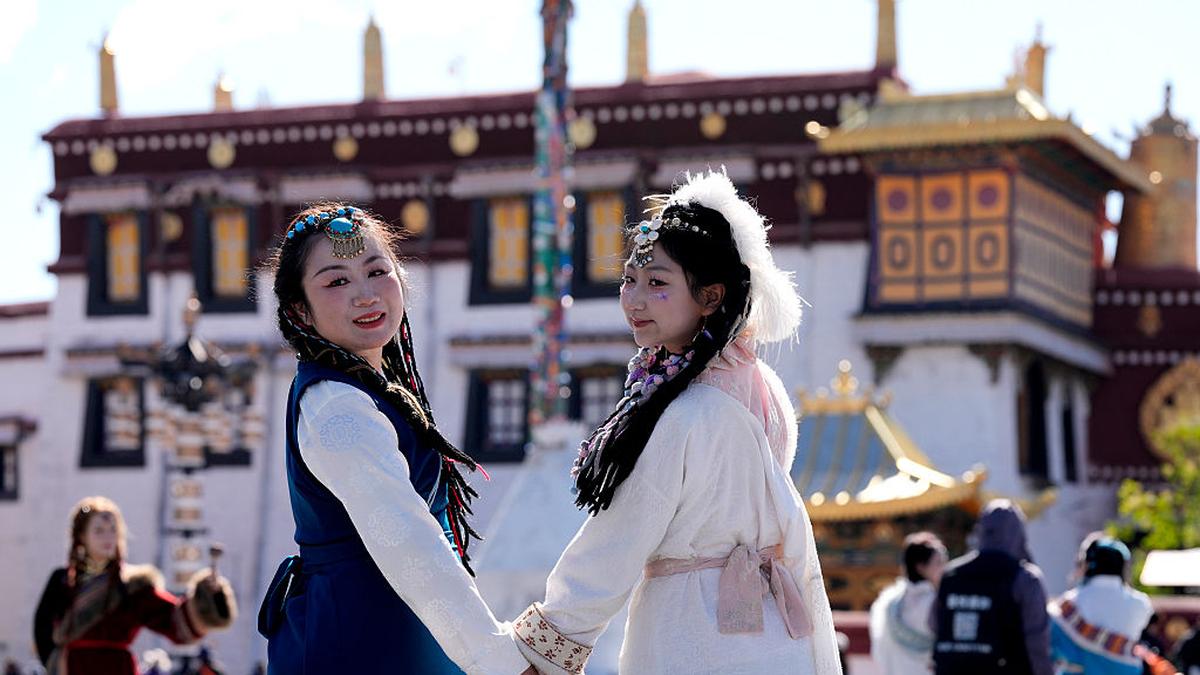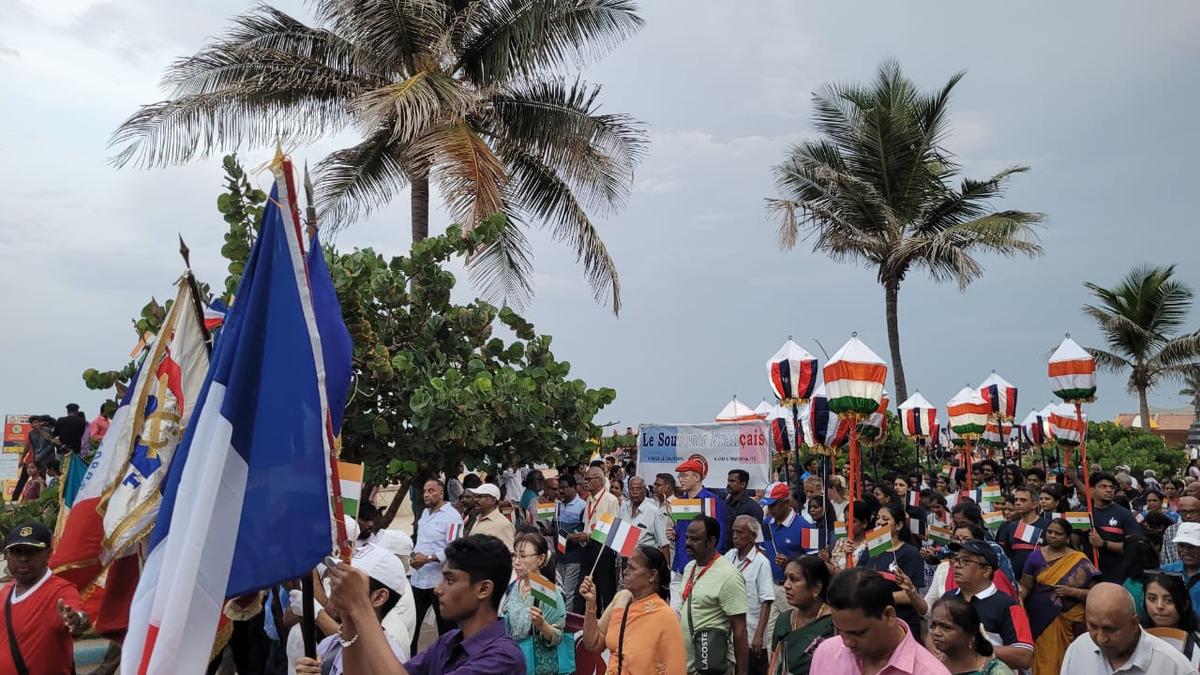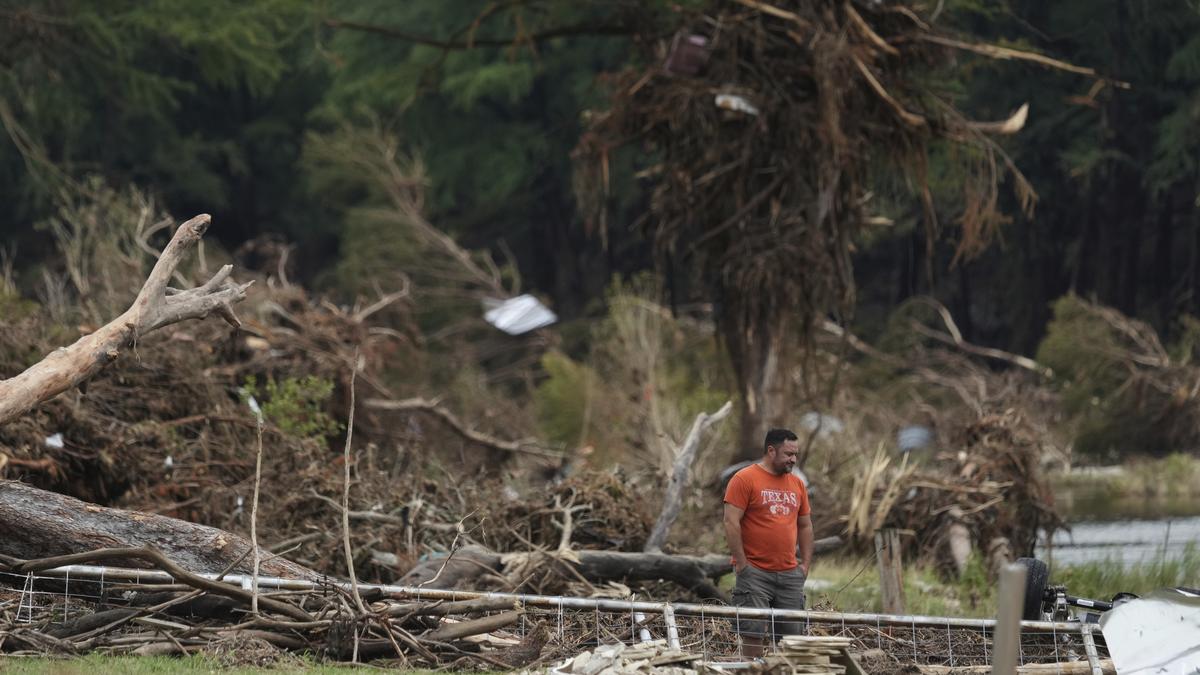The changes in Tibet’s Lhasa are perhaps most evident in the heart of the old city, Barkhor Square, where the revered Jokhang Temple stands. Built in 639 CE by the “first king of unified Tibet”, Songtsen Gampo, the deities of the Buddha were brought by his two wives, Tang Dynasty’s Princess Wencheng and Princess Bhrikuti from Nepal.
Built around this temple, where Buddhists would do a daily parikrama, was a bustling market. In 2007, it was packed with stalls selling jewellery, handicrafts, wooden bowls, prayer flags, incense and food. Today, Barkhor stands as an empty piazza, with shops at the far ends of the square.
Watch: The developing city of Tibet – Lhasa | Kailash Manasarovar Yatra
Decades-long transformation
In 2012, as part of a drive to give Lhasa a facelift, the stalls were cleared, and street vendors moved from outside the Jokhang temple, and along the main Youthok Lam (street) that leads to the Potala Palace. The signage is now almost entirely in Chinese, and the shopkeepers belong to China’s Han ethnic majority unlike in the past, when they were mostly Tibetan.
Many of those moved out are now housed in a multi-story concrete mall, Tibet Market. On the ground floor, the main corridor has more Han shopkeepers, with Tibetans relegated to the lines behind or floors above. Inside the Jokhang Temple, and at the opera, Princess Wencheng, which has been performed in Lhasa and other parts of the Tibetan Autonomous Region (TAR) for more than a decade, the Chinese queen, and link to Buddhism are played up over the ties to Nepal and India. This summer, Lhasa hosted another opera — a combination of a local epic, King Gesar, with the Confucian Shi Jing (Book of Poems).
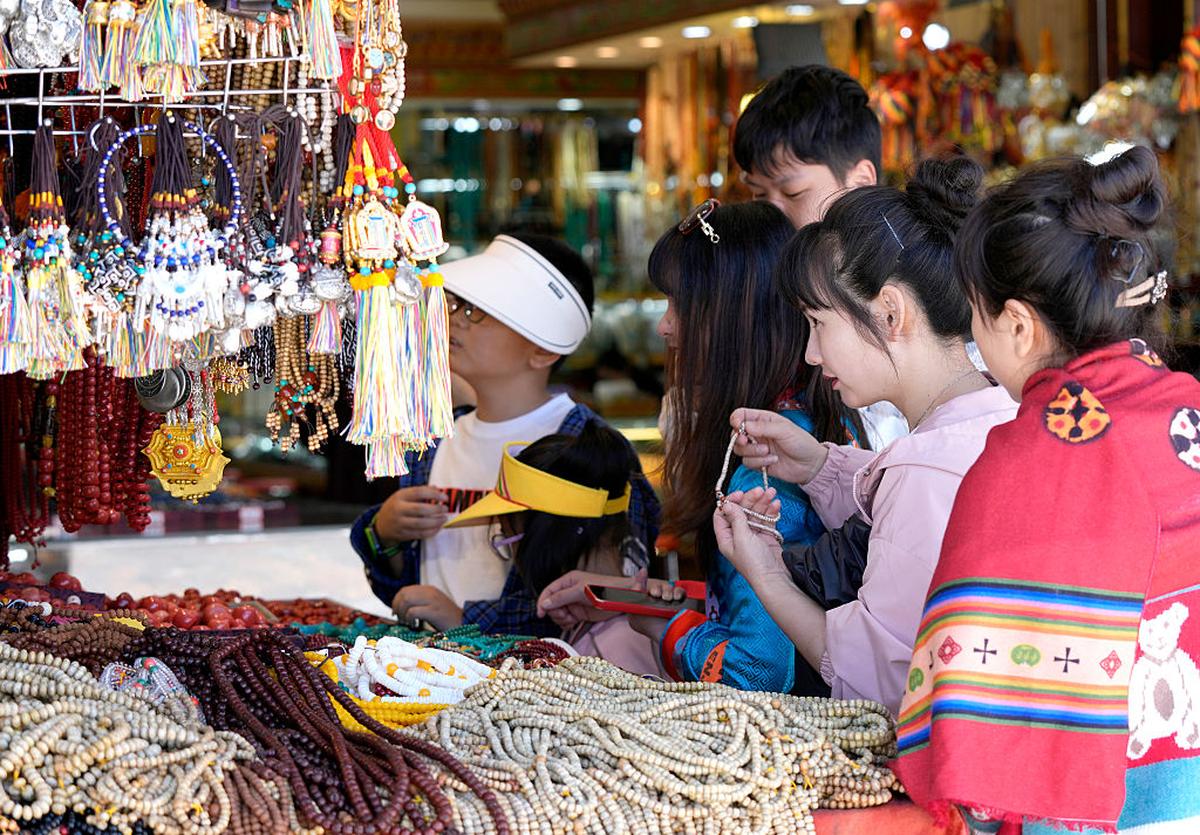
Tourists shop for souvenirs on Barkhor Street in Lhasa.
| Photo Credit:
Via Getty Images
The three most visible changes at Barkhor Square — infrastructural, demographic and cultural — represent the transformation of Tibet over the past few decades. As a member of three Indian journalist delegations invited to Lhasa by the Chinese Ministry of Foreign Affairs, I have witnessed these changes during visits in 2007, 2014 and June 2025.
Infrastructural changes
After annexing Tibet in 1950, most of the Chinese government’s planning focused on security, especially concerning Tibetan Buddhism and monks. During the Cultural Revolution (1966-1976), Jokhang Temple was closed for worship. But, by the turn of the century, there was a shift towards controlling the region through a blitzkrieg of investment. China’s 10th Five-Year Plan (2001-2005), cleared by the National People’s Congress, allocated over $4 billion for infrastructure development in Tibet, which rose to $21 billion in the 11th Five-Year Plan (2006-10), for developing expressways, a high-speed rail project, and more than 300 key projects.
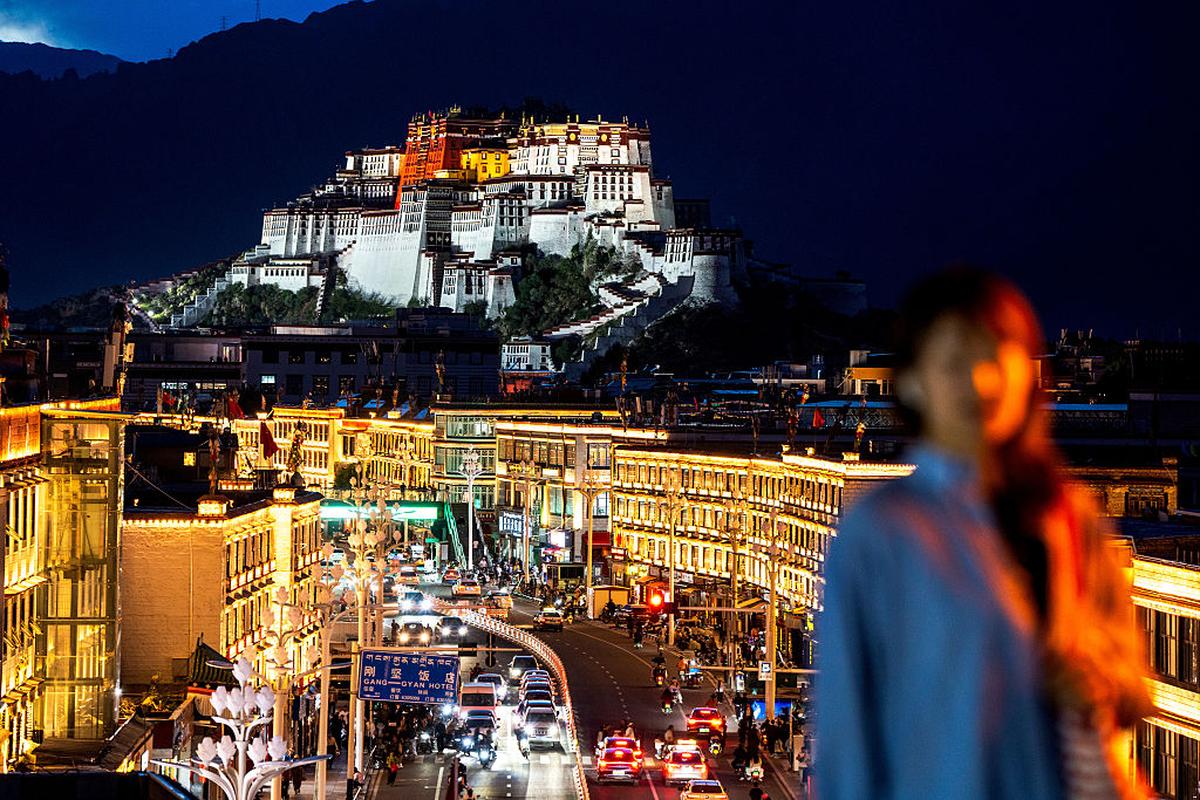
A view of the illuminated city streets of Lhasa, with Potala Palace in the distance.
| Photo Credit:
Via Getty Images
The launch of the Beijing-Lhasa train in 2006, which defied the steep climb to the Qinghai plateau, was hailed as an engineering marvel but speeded the influx of mainland Chinese to the region. The drive from the airport to Lhasa city, which once took almost three hours, now takes just 45 minutes due to tunnels bored through the mountains, and solar panels everywhere indicate a renewable energy transition. Experts and Tibetan activists say that the rapid construction of roads, tunnels, airports, and concrete cities like New Lhasa, across the Kyichu (Lhasa River) from Old Lhasa, has caused environmental damage, speeded global warming, and melted glaciers in a land that cradles the world’s highest mountains and is the source of many of Asia’s rivers. According to our tour-guides, rising temperatures in Lhasa and disappearing snow, even over Mount Kailash, are palpable.
The construction, mining and malls mandated by the Chinese government’s development plans have brought many workers and mainland Chinese seeking jobs. We meet many in the shopping areas as well as the government offices we visit. From 2010 to 2020, the population of Tibet (or Xizang, as the ruling Communist Party of China (CPC) mandated the region’s six prefectures be called in official documents) grew from about 2.7 million to 3.1 million. But the percentage of Tibetans or ethnic minorities dropped from nearly 90% to 86%, indicating a demographic change.

Tourists pose for a photo with the Potala Palace in the background, in Lhasa, June 2025.
| Photo Credit:
Via Getty Images
Linguistic politics
The language in Lhasa has shifted — Mandarin Chinese (Putonghua) is taught in schools to inculcate “national unification and strengthen ethnic unity” through a “modern education” according to a 2023 CPC paper. All official documents and signage now use the Chinese name ‘Xizang’ and not Tibet.
At Lhasa’s School Number 8 — where many international delegations are brought — the main language of instruction appears to be Mandarin, though we were taken to a class where students were chanting in Tibetan, and another where a scholar was practising the Tibetan script. This is a sensitive subject for the Chinese government, amid UN Special Rapporteurs’ criticism that about 1 million Tibetan children had been “separated from families” and pushed into schools that sought to “assimilate Tibetans into majority Han culture”. While the CPC paper details measures to continue the study of Tibetan Buddhism “adapted to China’s reality”, it also lists cultural changes that are more obvious to the eye in Lhasa.
A view of the Chinese government-run school in Lhasa.
| Photo Credit:
Suhasini Haidar
Relocation projects for poorer and rural Tibetans resemble Beijing hutongs (alleyways lined with houses) rather than smaller, colourful Tibetan homes seen in the countryside. There, we meet Tibetan families in a room where photographs of Chinese President Xi Jinping and Chairman Mao are prominently displayed. Security forces, that we saw regularly in 2007, patrolling Lhasa streets with riot control gear and cattle-prongs to deal with self-immolation protests, are less visible. In busy areas, we see high-tech police surveillance vans, however.
The disappearance of links to India, a regular travel destination for Tibetans now more restricted by a heavily controlled Nepal-Tibet border, is evident. In 2007, stalls at Barkhor sold Bollywood DVDs, shops stocked Indian products, and monks at Jokhang and the Potala Palace spoke to us in Hindi. Two decades later, very few speak, or admit to speaking, Hindi at all.
Erasing the Dalai Lama
The 14th Dalai Lama, surrounded by visitors and devotees, including Hollywood actor Richard Gere (right) and India’s Minister of Parliamentary Affairs Kiren Rijiju (far left) during his 90th birthday celebrations in Dharamshala.
| Photo Credit:
Reuters
The biggest change centres on erasing any reference to the 14th Dalai Lama, now 90 years old. He escaped from Lhasa 65 years ago, but his influence remains a concern for the Chinese government. All photographs of him are banned, and worshipping him is illegal. However, in 2007, I met Tibetans who, recognising me as an Indian, asked about him and showed photos concealed in their jackets, or behind shop counters.
In 2014, during a brief period of openness following Chinese government talks with Dalai Lama representatives, we visited his summer home in Norbulingka, where Tibetans thronged to offer khadas (silk scarves) to his belongings — furniture, a radio set, even a towel rack.
This time, we are told Norbulingka is closed. I ask a young man in Barkhor if he is following the Dalai Lama’s birthday celebrations in Dharamshala. “Yes,” he says, pointing to his chest as he looks around furtively, and adds, “but only inside my heart.”
suhasini.h@thehindu.co.in
